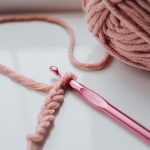Are you ready to learn how to sew chiffon fabric?
In this article, we’ll guide you through the process step by step.
You’ll discover the right needle and thread to use, as well as how to prepare and cut the fabric.
We’ll show you techniques for pinning, marking, and adjusting the tension on your sewing machine.
Plus, we’ll share tips for stitching, hemming, and finishing edges.
Get ready to create beautiful chiffon garments with ease!
Table of Contents
Choosing the Right Needle and Thread
To sew chiffon fabric, you’ll want to use a fine needle and lightweight thread. These tools are essential for achieving clean and precise stitches on delicate fabrics like chiffon.
When it comes to sewing techniques, it’s important to handle chiffon with care to avoid snags or pulls. Start by selecting a fine needle, preferably a size 9 or 11, which will glide smoothly through the fabric without causing any damage. Pair this with lightweight thread, such as polyester or silk thread, which will reduce the risk of puckering or gathering.
When sewing chiffon, it’s best to use a straight stitch or a narrow zigzag stitch. Additionally, using a sharp pair of fabric scissors will ensure clean cuts and prevent fraying.
Troubleshooting tips include using tissue paper or tear-away stabilizer underneath the fabric to prevent it from getting caught in the machine’s feed dogs. It’s also helpful to test your sewing machine settings and tension on a scrap piece of chiffon before starting your project.
Preparing and Cutting the Chiffon Fabric
When it comes to working with chiffon fabric, there are several key points to consider.
Fabric handling techniques are important in achieving clean and precise cuts. Using sharp scissors and handling the fabric gently can help you achieve this.
Choosing the right tools can also make a big difference in preventing fraying edges and ensuring a professional finish. Rotary cutters and pinking shears are recommended for working with chiffon fabric.
Fabric Handling Techniques
You’ll want to be gentle with chiffon fabric when handling it. Chiffon is a delicate and lightweight fabric that requires special care to avoid any damage.
When working with chiffon, it’s important to use fabric draping techniques to ensure smooth and flowing lines. Start by handling the fabric with clean hands to avoid any stains or dirt. Avoid pulling or stretching the fabric too much, as it can easily tear.
Use sharp scissors to cut the fabric, and make sure to place tissue paper or a stabilizer underneath to prevent slipping. If you encounter any common chiffon sewing problems, such as fraying edges or puckering, try using a smaller needle size or adjusting the tension on your sewing machine.
Choosing the Right Tools
Using the right tools is essential for achieving successful results in your sewing projects. When working with delicate fabrics like chiffon, it’s crucial to have the appropriate tools to ensure a smooth and professional finish. Here are some essential tools and their functions:
| Tool | Function |
|---|---|
| Fine pins | Secure fabric without causing damage |
| Sharp scissors | Cut chiffon smoothly and accurately |
| Lightweight needle | Prevents fabric from being damaged during stitching |
| Seam ripper | Fix any mistakes without damaging the fabric |
| Narrow hem foot | Create clean and narrow hems easily |
In addition to using the right tools, it’s important to maintain your sewing machine properly. Regular cleaning and oiling will ensure smooth operation and prevent damage to the delicate chiffon fabric. Also, keep in mind that there are different types of chiffon fabric, such as silk chiffon and polyester chiffon, each requiring specific handling and sewing techniques. By using the right tools and understanding the characteristics of different chiffon fabrics, you can achieve beautiful and professional sewing results.
Preventing Fraying Edges
To prevent fraying edges, it’s important to choose the right tools and techniques.
When working with chiffon fabric, which is delicate and prone to fraying, you need to use seam finishes that will secure the edges and prevent them from unraveling.
One effective technique is a French seam. This involves sewing the fabric with wrong sides together first, and then folding it in half and sewing it again with right sides together. This encloses the raw edges within the seam, preventing fraying.
Another option is using a narrow zigzag stitch or an overlock stitch on a serger machine to finish the edges. These stitches create a secure and neat edge that will resist fraying.
Pinning and Marking the Fabric
When it comes to pinning and marking your chiffon fabric, precise techniques are essential. Accurate pinning ensures that your fabric stays in place while you work, preventing any shifting or distortion.
Additionally, proper marking helps you achieve precise cuts and accurate placement of design elements, resulting in a polished finished product.
Precise Pinning Techniques
For precise pinning techniques on chiffon fabric, make sure you’re careful not to snag or damage the delicate material. Chiffon is a lightweight and sheer fabric that requires special handling. Here are some tips to help you pin chiffon accurately and without causing any harm:
- Use sharp, thin pins: These will glide easily through the fabric without leaving visible holes or snags.
- Pin within seam allowances: This will ensure that the pins are hidden when you sew the fabric together.
- Pin parallel to the grainline: Pinning along the grainline will prevent distortion and ensure a smooth finish.
- Avoid pinning too close to the edge: Chiffon can easily fray, so leave a small distance between the pin and the fabric edge.
By following these pinning techniques, you can confidently work with chiffon and achieve professional-looking results.
Remember to also use marking techniques such as tailor’s chalk or fabric markers to accurately mark your pattern pieces on chiffon.
Importance of Accurate Marking
Accurate marking is essential for achieving precise and professional results when working with delicate materials like chiffon. Properly marking your fabric ensures that your sewing lines are straight and your garment fits correctly.
One important aspect of accurate marking is the importance of pressing. Pressing your chiffon fabric before marking will help remove any wrinkles or creases, allowing for more accurate measurements and markings.
Additionally, using fine-tipped marking tools, such as disappearing ink pens or tailor’s chalk, will help you make precise and easily removable marks on your fabric.
When working with delicate fabrics like chiffon, it is also important to handle them with care to avoid snags or tears. Always use sharp, fine needles and sew slowly to prevent any mishaps.
Adjusting the Tension on Your Sewing Machine
To properly sew chiffon fabric, you’ll want to make sure you adjust the tension on your sewing machine. Adjusting the tension is essential for achieving smooth and even stitches on delicate fabrics like chiffon. When the tension is too tight, the fabric can pucker and create unsightly wrinkles. On the other hand, if the tension is too loose, the stitches may appear loose and the fabric could gather or fray.
To adjust the tension on your sewing machine, start by referring to the manual for specific instructions, as the process may vary depending on the machine model. Typically, there is a tension dial or knob located on the front or side of the machine. Gradually turn the dial or knob to adjust the tension. It’s important to make small adjustments and test the stitches on a scrap piece of fabric to ensure the desired result. If you notice any issues, such as loose or tight stitches, try adjusting the tension in the opposite direction until you achieve the desired stitch quality.
If you’re having trouble troubleshooting the tension on your sewing machine, consider consulting a professional or contacting the manufacturer for assistance. They will be able to provide guidance specific to your machine model and help you troubleshoot any issues you may be experiencing.
Stitching Techniques for Chiffon Fabric
When stitching delicate materials like chiffon, it’s important to use a smaller needle to prevent any damage to the fabric. Chiffon is a lightweight and sheer fabric, and it requires special care and techniques to achieve professional-looking results.
Here are some stitching techniques for working with delicate fabrics like chiffon:
-
Use a smaller needle: Opt for a fine needle, such as a size 9 or 11, to avoid leaving large, visible holes in the fabric.
-
Lower the machine tension: Adjust the tension setting on your sewing machine to a lower number to prevent the fabric from puckering or pulling.
-
Use a straight stitch: When sewing chiffon, use a straight stitch rather than a zigzag stitch to minimize the risk of the fabric getting caught in the machine.
-
Use a light touch: Apply gentle pressure when guiding the fabric through the machine to avoid stretching or distorting the delicate chiffon.
-
Test on scraps: Before sewing on your actual garment, test your stitching techniques on scraps of chiffon to ensure the desired results.
Hemming and Finishing Edges
For a professional finish on your garment, remember to trim any excess fabric before hemming and use a narrow rolled hem technique. Hemming is an essential step in sewing, as it gives your garment a polished and clean look.
There are various hemming techniques you can use, but for delicate fabrics like chiffon, a narrow rolled hem is ideal. To achieve this, fold the edge of the fabric twice, about 1/8 inch each time, and stitch close to the folded edge. This technique creates a neat and narrow hem that is barely visible from the outside.
When hemming chiffon, it’s important to handle the fabric gently to avoid fraying. Before stitching, trim any loose threads or excess fabric to ensure a clean edge. Using sharp scissors or a rotary cutter with a fresh blade will help you achieve precise cuts. Take your time and work slowly, allowing the fabric to glide smoothly under the needle.
Once you have completed the hem, don’t forget the finishing touches. Give your garment a final press using a cool iron or a pressing cloth to remove any wrinkles and create a crisp finish. Pay attention to the seams and edges, ensuring they lie flat and smooth.
And there you have it – a professionally hemmed chiffon garment ready to be worn with confidence.
Tips for Sewing Chiffon Seams
Using sharp scissors or a rotary cutter with a fresh blade will help you achieve precise cuts while hemming chiffon.
When sewing chiffon ruffles, it’s important to handle the delicate fabric with care.
To create gathers in chiffon fabric, you can use a gathering foot on your sewing machine. This handy tool evenly distributes the fabric while creating beautiful gathers.
Another technique is to sew two parallel rows of long basting stitches along the edge of the fabric and then gently pull the bobbin threads to gather the fabric. Remember to secure the gathers in place by stitching over them with a regular stitch length.
When sewing chiffon seams, it’s best to use a small, sharp needle and a lightweight thread. You can also try using a walking foot to prevent the layers of chiffon from shifting. Remember to test your stitches on a scrap piece of fabric first to ensure the tension is correct.
With these tips, you’ll be able to sew chiffon fabric with ease and achieve professional-looking results.
Caring for and Maintaining Chiffon Garments
To keep your chiffon garments looking their best, it’s important to gently hand wash them in cold water and lay them flat to dry. Chiffon is a delicate fabric that requires special care to maintain its beauty and longevity. Avoid using harsh detergents or bleach, as they can damage the delicate fibers of chiffon. Instead, opt for a mild detergent specifically designed for delicate fabrics.
When washing chiffon, it’s best to avoid wringing or twisting the fabric, as this can cause it to stretch or lose its shape. Gently squeeze out any excess water and then lay the garment flat on a clean towel to dry. Avoid hanging chiffon garments as this can cause them to stretch or develop unwanted creases.
When it comes to ironing chiffon, it’s important to use a low heat setting or even a steamer to remove any wrinkles. Always place a pressing cloth or a thin cotton towel between the iron and the fabric to protect it from direct heat. Move the iron in a gentle, sweeping motion to avoid damaging the delicate fibers.
Here’s a quick reference guide for caring for your chiffon garments:
| Care Tips for Chiffon Garments | |
|---|---|
| Washing | Hand wash in cold water with a mild detergent. Avoid wringing or twisting the fabric. Lay flat to dry. |
| Drying | Lay the garment flat on a clean towel to dry. Avoid hanging to prevent stretching or creasing. |
| Ironing | Use a low heat setting or a steamer to remove wrinkles. Place a pressing cloth or thin cotton towel between the iron and the fabric. Move the iron gently in a sweeping motion. |
Conclusion
In conclusion, sewing chiffon fabric requires careful consideration of the needle, thread, and tension on your sewing machine.
Preparing and cutting the fabric, as well as pinning and marking it, are crucial steps to ensure accurate sewing.
Stitching techniques and hemming methods specific to chiffon fabric should be followed for optimal results.
Lastly, proper care and maintenance of chiffon garments will help them retain their elegance and longevity.
With these tips, you’re ready to confidently sew beautiful chiffon creations.
- Is Suede Fabric Good for Curtains? - July 12, 2025
- What Is Sueded Jersey Fabric? - July 12, 2025
- How to Clean Fabric Softener Stains Off Suede Shoes - July 12, 2025




